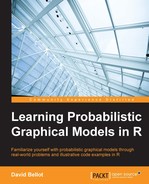In the second chapter, we introduced the fundamentals of inference and we saw the most important algorithms for computing posterior distribution: variable elimination and the junction tree algorithm. We learned how to build a graphical model by considering causality, temporal relationships, and by identifying patterns between variables. We saw a fundamental feature of probabilistic graphical models, which is the combination of graphs to build more complex models. And we learned how to perform inference with a junction tree algorithm in R and saw that the same junction tree can be used for any type of query, on both marginal and joint distribution. In the last section we saw several real-life examples of PGM that can be used in many applications and are usually good candidates for exact inference.
In this chapter, we faced a problem when defining a new graphical model: the parameters are tedious to determine. In fact, even on small examples it's complicated. In the next chapter we will learn how to find parameters automatically from a dataset. We will introduce the EM (Expectation Maximization) algorithm and experiment with a complex problem: learning the structure of the graph itself. We will see that inference is the most important sub-routine of all learning algorithms, hence the necessity for having efficient algorithms such as the junction tree algorithm.
